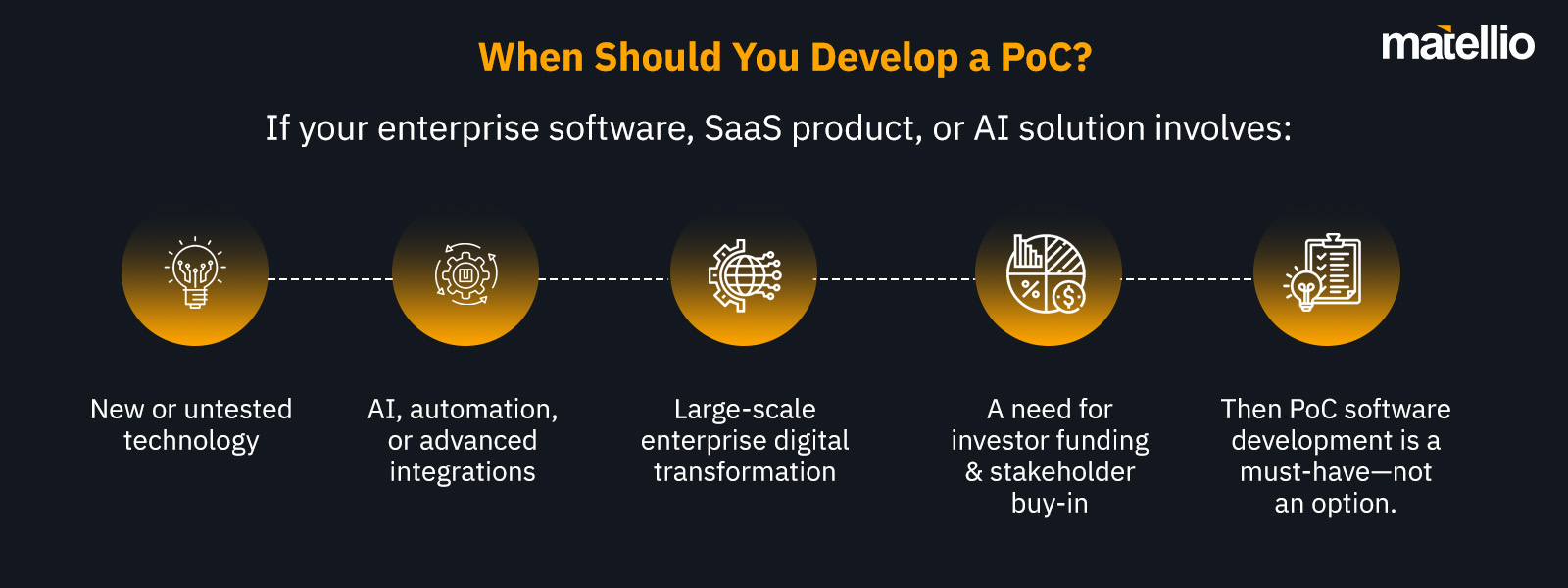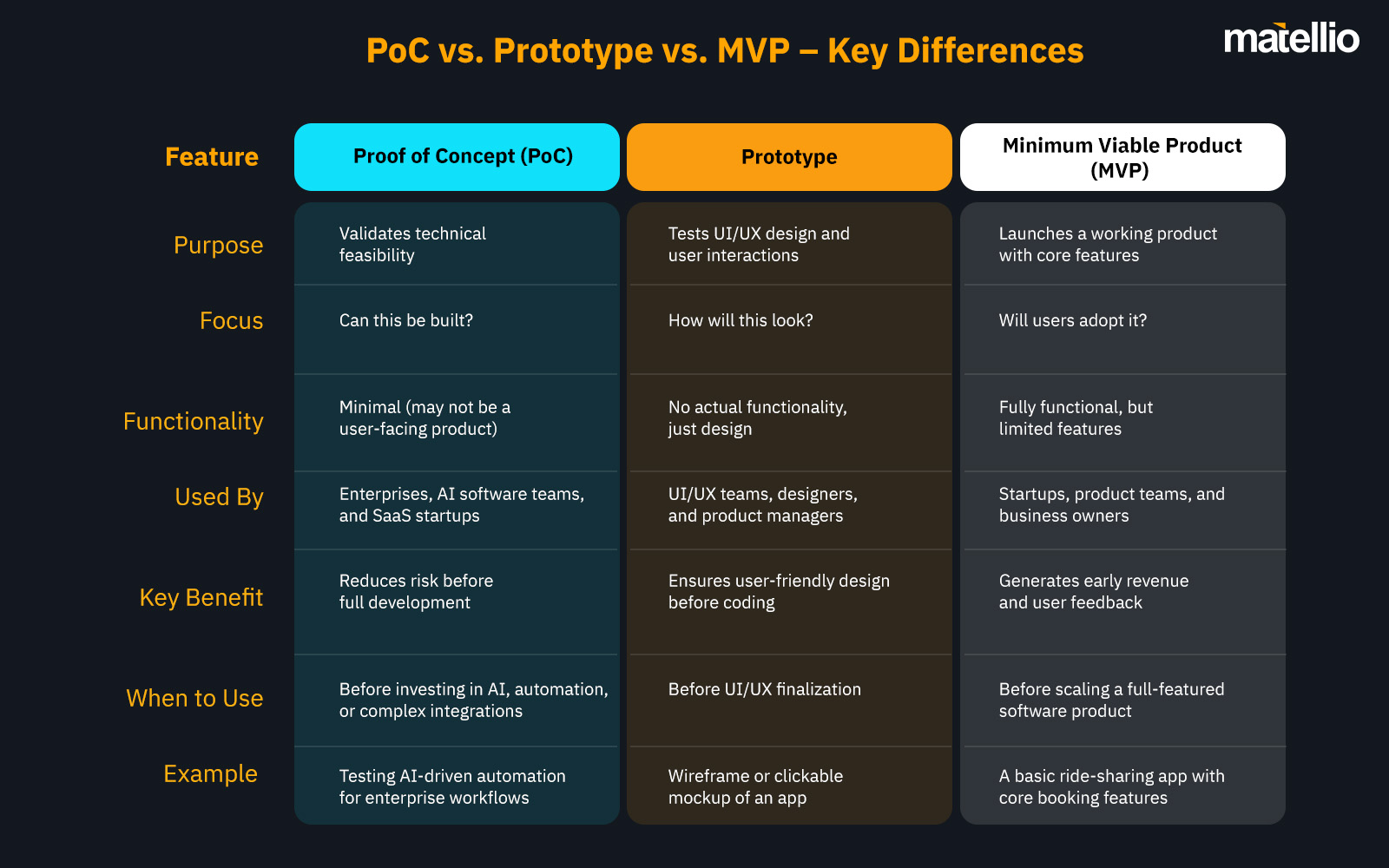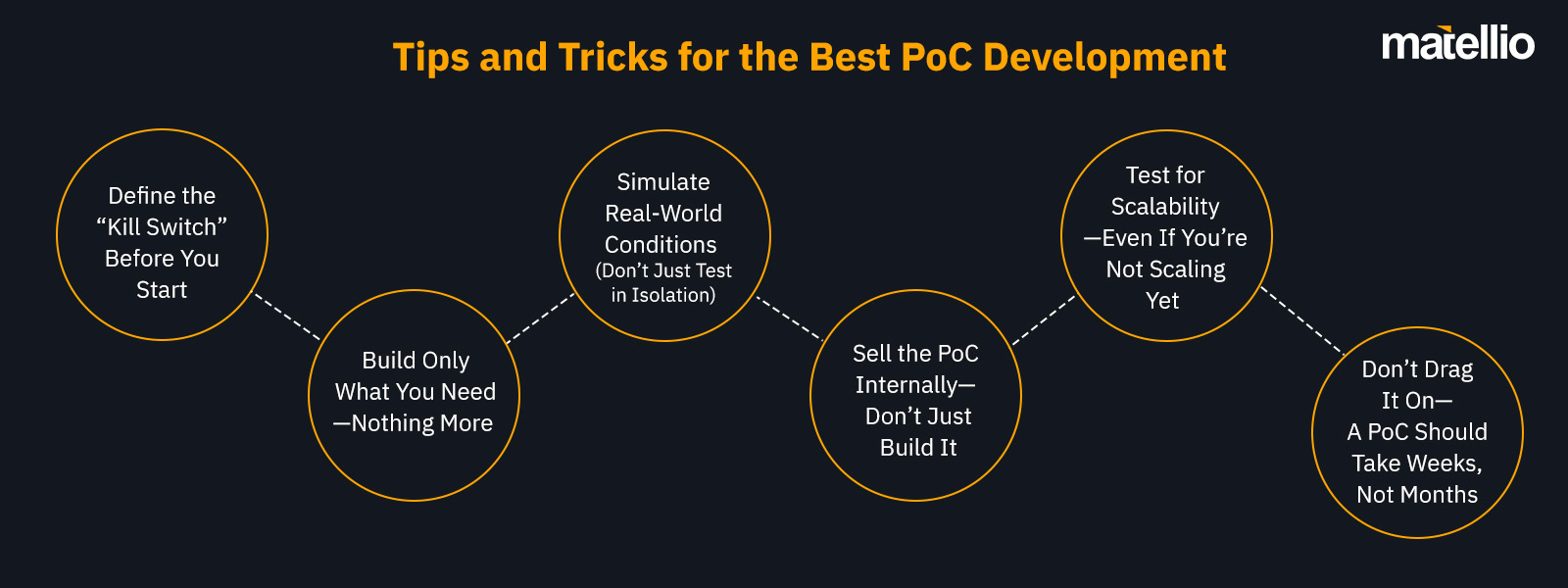
Did you know that almost 70% of digital transformation projects fail—not because the idea was bad, but because it was never validated properly before development? Well, that’s exactly where PoC development comes into play!
Most companies dive straight into full-scale software development, investing hundreds of thousands of dollars before ever testing if the core functionality is technically viable or market-ready. But with proof-of-concept, you can change that for your business!
A PoC is your safety net. It prevents massive financial losses, validates feasibility, and ensures your investment isn’t wasted on an unproven concept. It helps you:
- Confirm technical feasibility before investing in full-scale development
- Reduce time, money, and effort spent on avoidable failures
- Build investor confidence with real validation instead of assumptions
By the time most businesses realize their software won’t work as expected, they’ve already burned through their budget. Would you rather spend a few hundreds on a PoC or risk losing thousands or millions on full-scale failure?
If you’re serious about minimizing risk, securing investment, and launching a successful software product, PoC development isn’t optional—it’s the smartest first step.
What is PoC in Software Development
Every great software idea comes with uncertainty—Will it work? Will users adopt it? Will it integrate seamlessly into existing systems? Proof of Concept (PoC) development is the answer to eliminating these doubts before they turn into costly failures.
A PoC in software development is not a prototype, not an MVP, and definitely not a full-fledged product. It’s a small-scale test to validate feasibility, identify risks, and prove that your software concept can actually work.
Why do enterprises and startups develop PoC?
Because without PoC software development, companies waste time, resources, and money on projects that are technically impractical or fail to meet market demands.
By investing in PoC development services, businesses can:
- Avoid wasting months on an idea that doesn’t work
- Validate market fit before full-scale development
- Attract investors with a proven, tested concept
- Ensure seamless integration with existing enterprise systems
Skipping PoC is not an option if you want to develop scalable, high-impact software.
But do you know that there are different types of PoC, each suitable for a specific business need? Different businesses require different types of PoC development processes to test various aspects of their software idea. Here are the most effective approaches:
Technical PoC – Testing Feasibility Before Development
Used when businesses need to verify if the software can technically function within their existing infrastructure. This is critical for AI-powered solutions, cloud-based platforms, and enterprise system integrations.
Business Model PoC – Validating Market Demand
For startups and SaaS companies, developing PoC focused on business viability ensures that the idea is worth investing in before scaling.
Integration PoC – Ensuring Seamless System Compatibility
For enterprises with legacy systems, system integration services are critical. This PoC ensures new solutions can connect with existing ERP, CRM, or cloud environments.
UX/UI PoC – Testing User Experience Before Full Development
Developing PoC focused on user experience helps businesses validate UI/UX design, gather early feedback, and refine usability.
AI/ML PoC – Validating AI Performance & Predictive Accuracy
Before implementing AI integration services, businesses need to test AI models, evaluate performance, and ensure reliable outputs before scaling AI-driven applications.
Choosing the right PoC product development approach is the first step to ensuring that your software is built for success.
The Biggest Risks of Skipping PoC in Software Development
Think about this: You invest months of time and hundreds of thousands of dollars into developing a SaaS product, AI solution, or enterprise software—only to realize it doesn’t work as expected, doesn’t integrate with your systems, or doesn’t even have a market.
Skipping PoC development isn’t saving time—it’s setting yourself up for failure.
Here’s what happens when businesses jump straight into full-scale development without a proof of concept in software development:
Delayed Development Timelines = Lost Market Opportunity
If your team discovers technical challenges mid-development, you’ll have to rework the code, delay launch, and miss critical market timing.
How PoC Development Solves This:
- Identifies risks before full-scale development begins
- Prevents unnecessary delays caused by late-stage reworks
- Ensures your software is ready for rapid deployment
Would you rather test early with PoC software development or spend months fixing issues later?
Wasted Budget on Unproven Features & Poor Market Fit
Enterprises spend millions building software that users don’t want or that lacks critical functionality. Startups burn through their funding on assumptions instead of validation.
How PoC Development Services Solve This:
- Validates market demand before building a full product
- Saves money by focusing only on viable, high-impact features
- Gives investors confidence that your concept is worth funding
Investing in a PoC product development approach means spending smart—not gambling on assumptions.
Technical Unfeasibility & Integration Failures
The worst time to realize your solution can’t integrate with your existing CRM, ERP, or cloud systems is after development. Enterprises without a PoC development process often end up with software that doesn’t work within their infrastructure.
How PoC for Software Development Solves This:
- Confirms technical feasibility before full-scale development
- Ensures seamless system compatibility with system integration services
- Reduces risks in AI-driven applications with AI integration services
If your software can’t integrate, it won’t be adopted—PoC development ensures it will.
Investor & Stakeholder Hesitation = Slower Growth
Investors and executives won’t fund a project that’s built on guesswork. Without a PoC in software development, securing funding or executive buy-in becomes a challenge.
How PoC Development Company Solutions Solve This:
- Provides a working proof that your idea is feasible
- Boosts investor confidence with real validation
- Accelerates time to funding and faster decision-making
Would you invest in a project that hasn’t been tested? Neither will investors.
The bottom line? Skipping PoC is a guaranteed way to increase risk, burn capital, and delay success. Whether you’re an enterprise integrating new solutions or a startup looking for funding, proof of concept development is the smartest first step in software success. Submit RFP today to get started with PoC development!
How PoC Development Helps Enterprises & Startups Save Millions
In the competitive landscape of software development, both enterprises and startups face significant financial risks. Implementing a robust Proof of Concept (PoC) development process is a strategic move to mitigate these risks and ensure a higher return on investment.
Validating Market Demand Before Major Investment
A staggering 42% of startups fail due to a lack of market need for their product. By engaging in PoC development, businesses can test their concepts in real-world scenarios to assess market demand before committing substantial resources.
Benefits:
- Early Detection of Market Misalignment: Identifies potential mismatches between the product and market needs, allowing for timely pivots.
- Resource Optimization: Ensures that time and capital are invested in concepts with proven market viability.
- Enhanced Investor Confidence: Demonstrates due diligence, making the venture more attractive to potential investors.
Ensuring Smooth System Integration Before Full-Scale Rollout
Enterprises often invest heavily in software solutions that ultimately fail due to integration issues with existing systems. A PoC serves as a preliminary test to ensure compatibility and seamless integration, preventing costly failures post-deployment.
Benefits:
- Technical Feasibility Assessment: Evaluates whether the new solution can be effectively integrated into the current infrastructure.
- Risk Mitigation: Identifies potential technical challenges early, allowing for proactive solutions.
- Cost Savings: Prevents financial losses associated with late-stage integration failures.
Demonstrating Feasibility to Increase Funding Potential
Investors are more inclined to fund projects that have been validated through a PoC. A well-executed PoC showcases the practicality and potential success of the software, making it a compelling case for investment.
Benefits:
- Proof of Viability: Provides tangible evidence that the concept works as intended.
- Competitive Advantage: Distinguishes the project in the eyes of investors by demonstrating a lower risk profile.
- Accelerated Funding: Facilitates quicker investment decisions, expediting the development process.
Accelerating Time-to-Market with Informed Decision-Making
A PoC enables faster decision-making by providing quick insights into the feasibility and potential challenges of the project. This agility allows businesses to adapt swiftly, reducing time-to-market and gaining a competitive edge.
Benefits:
- Rapid Validation: Quickly assesses the viability of the concept, allowing for prompt adjustments.
- Efficient Resource Allocation: Directs efforts towards concepts with the highest potential for success.
- Market Responsiveness: Enables the business to capitalize on market opportunities ahead of competitors.
Cost-Effective Development Through Early Issue Identification
By identifying potential issues early in the development process, a PoC helps avoid costly mistakes down the line. This proactive approach ensures that you utilize dedicated developers efficiently, leading to significant cost savings.
Benefits:
- Early Problem Detection: Uncovers technical or conceptual issues before they escalate.
- Reduced Development Costs: Minimizes expenses by addressing problems early when they are less costly to fix.
- Improved Budget Management: Allows for more accurate budgeting and financial planning.
Enhancing Stakeholder Engagement and Confidence
A successful PoC not only validates the concept but also engages stakeholders by involving them in the early stages of development. This involvement builds confidence and ensures that the project aligns with stakeholder expectations.
Benefits:
- Stakeholder Alignment: Ensures that all parties have a clear understanding and agreement on the project’s direction.
- Increased Buy-In: Encourages active participation and support from stakeholders.
- Transparent Communication: Facilitates open dialogue, leading to better collaboration and project outcomes.
All in all, incorporating a Proof of Concept in software development is not just a preliminary step; it’s a strategic necessity that safeguards your investment, optimizes resources, and positions your project for success. By validating the feasibility and market demand early on, businesses can navigate the complexities of software development with confidence and clarity.
Ready to Test Your Concept Using PoC Development Services? Get Started with a Free 30-min Consultation!
When is PoC Development Essential in Software Development?
Now that you understand the risks of skipping PoC development and the massive business benefits it brings, the next logical question is:
“When do I actually need to develop PoC for my business?”
Not every software project needs a PoC, but for enterprises and startups looking to minimize risk and maximize ROI, PoC software development is non-negotiable in key scenarios.

Then PoC software development is a must-have—not an option.
Whether you are an enterprise planning a large-scale digital transformation or a startup testing an innovative software idea, knowing when to leverage PoC development services can save millions in development costs, reduce technical failures, and accelerate market success.
PoC Development for Enterprises: Validating Complex & Large-Scale Solutions
Enterprises deal with legacy systems, large datasets, cross-departmental workflows, and complex integrations. Jumping straight into full-scale development without a proof of concept in software development can result in disruptions, security vulnerabilities, and financial loss.
Here’s when PoC for software development is essential for enterprises:
Testing AI & Automation in Business Workflows
Many enterprises are automating operations using AI chatbot development services, RPA, and predictive analytics. However, implementing AI in mission-critical workflows without testing feasibility is a risk.
How PoC Development Solves This:
- Validates AI-powered decision-making before full implementation
- Ensures seamless integration with existing enterprise applications
- Identifies automation gaps and optimizes AI model development
Before deploying AI in your enterprise, test it with a PoC development process to avoid operational failures.
Validating Enterprise System Integrations
Most enterprises rely on ERP, CRM, cloud platforms, and internal databases. The biggest challenge? Ensuring new software integrates smoothly without data loss or operational downtime.
How PoC Development Services Solve This:
- Confirms compatibility with cloud integration services and system integration services
- Prevents expensive rework by identifying technical roadblocks early
- Reduces risk by simulating real-world enterprise operations
Before you develop enterprise-grade software, PoC product development ensures seamless system integration.
Exploring Emerging Technologies for Competitive Advantage
Enterprises looking to implement LLM as a Service for decision-making or IoT for real-time tracking must first ensure these technologies align with business goals and existing infrastructure.
How Developing PoC Helps:
- Tests feasibility of next-gen tech before full-scale deployment
- Eliminates uncertainty in AI, ML, or IoT adoption
- Validates business impact and operational scalability
A PoC in software development ensures emerging technologies actually work for your business before a major investment.
Before Large-Scale Digital Transformation Initiatives
Migrating to cloud infrastructure, revamping security architecture, or implementing company-wide automation without a PoC is a high-risk move that can lead to major financial losses.
How PoC Software Development Mitigates Risk:
- Provides a controlled test environment before full implementation
- Identifies security gaps and compliance challenges
- Ensures scalability before deployment across departments
Before you invest in enterprise-wide digital transformation, develop PoC to safeguard your investment.
PoC Development for Startups: Securing Market Fit & Investor Confidence
For startups, every dollar counts. Without a validated concept, startups risk wasting capital on unproven ideas. Investors are also hesitant to fund startups without technical feasibility validation.
Here’s when proof of concept development is critical for startups:
Before Pitching to Investors
Investors don’t fund ideas—they fund proven, tested solutions. Without a PoC, startups struggle to demonstrate technical feasibility and market potential.
How PoC Development Services Help Startups Get Funded:
- Creates a working proof that the concept is viable
- Reduces investment risk by demonstrating feasibility
- Increases chances of securing funding faster
If you need funding, a PoC for software development is your strongest pitch tool.
Testing Market Demand Before Full Development
A common reason 90% of startups fail is because they build products no one actually wants. Developing PoC first prevents this costly mistake.
How PoC Development Process Validates Market Fit:
- Confirms that users actually need and will pay for your product
- Gathers early customer feedback to refine features
- Prevents startups from wasting time on non-essential functionalities
A proof of concept in software development ensures your startup builds what the market truly needs.
Technical Feasibility of Innovative Features
Many startups want to integrate AI, IoT, RPA services, or complex automation, but without a PoC development process, they risk discovering technical limitations too late.
How PoC Development Solves This:
- Validates if AI, ML, or automation features will function as expected
- Identifies limitations in real-world implementation
- Helps refine technical architecture before full-scale development
Before investing in full-fledged software, PoC software development ensures your product can actually be built.
Reducing Risk Before MVP Development
Many startups jump straight into MVP development without validating their concept. This results in costly reworks, investor hesitation, and wasted resources.
How PoC Product Development Eliminates Risk:
- Ensures the software idea is technically feasible before full MVP
- Reduces costly development errors and reworks
- Increases investor confidence in your startup’s success
Before you launch an MVP, start with PoC development to minimize risk and maximize success.
Skipping PoC means skipping validation. Whether you’re scaling an enterprise or launching a startup, investing in PoC development services today ensures long-term success and cost efficiency.
Proof of Concept vs. Prototype vs. MVP – What Enterprises & Startups Need to Know
One of the biggest mistakes businesses make is confusing a Proof of Concept (PoC) with a Prototype or an MVP. If you’re planning to develop software, scale an enterprise solution, or pitch to investors, it’s crucial to understand the role of each approach and choose the right one for your project.
Think of it this way:
- A PoC in software development answers “Will this even work?”
- A Prototype answers, “What will this look like?”
- An MVP answers “Can this be launched to real users?”
Each has a different purpose, timeline, and impact on business success. Here’s how they compare:
Proof of Concept (PoC) – Testing Feasibility Before Development
A PoC development process is used to validate whether a software idea is technically feasible. Before investing in full-scale software development, enterprises and startups use PoC software development to:
- Confirm whether the concept is even possible
- Identify technical challenges early
- Ensure seamless integration with enterprise software development services
When to Choose PoC Development?
- If you need to validate AI, ML, or automation before full development
- If you’re building complex enterprise solutions that require system integration services
- If investors or stakeholders require technical feasibility validation before funding
Prototype – Testing User Experience & Design
A Prototype is a visual representation of the software that does not have actual functionality. It’s used to demonstrate UI/UX, design concepts, and user workflows.
When to Choose a Prototype?
- If you want to gather user feedback on design before coding
- If you need to validate UI/UX before investing in a full build
- If your team needs a clickable mockup for stakeholder presentations
Unlike a PoC development process, a Prototype does not test technical feasibility—it only focuses on visualizing how the software will look and feel.
MVP (Minimum Viable Product) – Testing Market Viability
An MVP is a working product with the core features needed for early users. It’s a lightweight version of the final product, designed to test market demand and gather real customer feedback.
When to Choose an MVP?
- If you have already validated feasibility through PoC development services
- If you need to launch a functional product with minimal investment
- If you want to test user adoption and generate revenue before full-scale development
Skipping the PoC product development phase and going straight to MVP development services increase the risk of technical failures and wasted budget.

So, which one should you choose?
- If you need to test technical feasibility, start with PoC software development.
- If you need to finalize UI/UX design, go with a Prototype.
- If you’re ready to launch a working version, develop an MVP.
Skipping PoC development means risking technical failures, budget overruns, and lost investor confidence. Before you build, validate your concept with a trusted PoC development company.
Expert Tips & Tricks to Ensure a Successful PoC Development
So, you’ve committed to PoC software development, and you’re following the right process. But let’s be honest—most PoCs fail, not because the idea was bad, but because the execution was flawed.
How do you make sure your PoC delivers real results?
Beyond just following a PoC development process, these expert-backed tricks will help you avoid common pitfalls, maximize impact, and ensure your proof of concept turns into a successful full-scale product.

Define the “Kill Switch” Before You Start
One of the biggest mistakes in PoC development services is not knowing when to stop. Many companies drag PoCs on for months, wasting resources on something that should have been shut down earlier or pivoted.
Pro Tip:
- Set clear success & failure criteria before you start developing PoC
- If the PoC fails to meet those criteria, kill it or pivot—don’t force it
- Define a fixed budget & timeline so the PoC doesn’t turn into full-scale development unintentionally
A PoC should validate an idea—if it’s not working, cut your losses early.
Build Only What You Need—Nothing More
Many businesses make the mistake of turning a PoC into a half-baked MVP. But a PoC isn’t a product—it’s just a feasibility test.
Pro Tip:
- Strip the PoC down to its core function—no extra features, no UI perfection
- Don’t build unnecessary integrations unless they’re critical for validation
- If you’re unsure whether something is essential, it probably isn’t
A leaner PoC = faster results, lower costs, and clearer validation.
Simulate Real-World Conditions (Don’t Just Test in Isolation)
A PoC that works in a test environment but fails in real-world usage is useless. Many PoC product development projects fail because they weren’t tested under real-world conditions.
Pro Tip:
- Use real datasets, real network conditions, and real integrations
- Simulate peak usage, downtime scenarios, and worst-case failures
- If integrating with cloud or enterprise systems, use cloud consulting services to ensure seamless functionality
A PoC that only works in a lab environment is a false positive—test in real conditions.
Sell the PoC Internally—Don’t Just Build It
If your PoC in software development is going to get funding or stakeholder buy-in, you need to sell its value. A great PoC won’t move forward if leadership doesn’t understand its impact.
Pro Tip:
- Create a clear, simple pitch deck for executives & investors
- Show hard data, test results, and cost-benefit analysis
- If possible, demo the PoC with real-world business impact
A PoC that doesn’t excite stakeholders will never move forward—make sure they see the potential.
Test for Scalability—Even If You’re Not Scaling Yet
Even though a PoC is a small test, if it can’t scale, it won’t succeed long-term.
Pro Tip:
- Design with scalability in mind from the start—use cloud-based architectures
- Test performance under simulated high loads using software testing services
- If integrating with enterprise systems, use system integration services to confirm seamless connectivity
A PoC that works on 10 users but breaks at 10,000 is a failed PoC—plan for growth.
Don’t Drag It On—A PoC Should Take Weeks, Not Months
A PoC that takes too long to complete loses momentum, focus, and funding. The longer it takes, the more likely it is to fail.
Pro Tip:
- Set a strict deadline—4 to 8 weeks max
- If the PoC takes too long, it’s either too complex or needs a pivot
- Use MVP development company expertise to streamline PoC timelines
A PoC that drags on loses value—validate quickly and move forward.
The Bottom Line: A PoC Should Be Quick, Focused, and Impactful
A successful PoC software development process isn’t just about building—it’s about:
- Proving feasibility as quickly as possible
- Keeping it lean & removing unnecessary complexity
- Ensuring real-world scalability & business impact
A well-executed PoC makes the difference between software success and failure. If you’re planning to build software, start with a Proof of Concept the right way—fast, focused, and validated.
Get Expert Assistance on Developing PoC for Your Business. Book a Free 30-min Consultation Today!
Steps to Follow for PoC Development – A Complete Roadmap for Business Owners
So, you’ve decided to develop PoC for your software solution, AI application, or enterprise system. Great! But where do you start?
A Proof of Concept in software development isn’t just about testing an idea—it’s about making smart, data-driven decisions that save time, money, and effort.
Many businesses fail at PoC development because they lack a structured approach or overcomplicate the process. To ensure success, follow these five essential steps when developing PoC.
Step 1: Define the Problem & Validate the Need
Before jumping into PoC software development, take a step back and ask: What problem are we solving?
Many businesses waste months developing features that users don’t need. A PoC should confirm that:
- The software solves a real business problem
- There’s actual demand for the solution in the market
- The technology can be built and scaled
How to Do It Right:
- Conduct market research and competitor analysis
- Interview potential users, customers, or internal stakeholders
- Identify key challenges that your software must address
If your idea doesn’t solve a real problem, no amount of PoC development services can make it successful.
Step 2: Partner with a Custom Software Development Company
Once you’ve defined your problem, it’s time to bring in experts in enterprise software development services.
Developing PoC isn’t just about testing feasibility—it’s about doing it right. A PoC development company ensures your idea is validated faster, smarter, and at lower costs.
Why You Need Experts for PoC Development:
- They help choose the best tech stack for PoC software development
- They ensure smooth integration with existing systems using system integration services
- They prevent costly technical mistakes that could derail the project
A trusted partner makes PoC software development 10x more efficient—don’t go at it alone.
Step 3: Build a Lean & Focused PoC
Many companies fail because they try to build an entire product at the PoC stage. A PoC should be minimalistic (only test the core functionality), fast to develop (4–8 weeks max), and focused on feasibility, not perfection
How to Do It Right:
- Prioritize the single most critical feature
- Use off-the-shelf solutions where possible (e.g., AI integration services instead of custom AI models)
- Keep UI/UX basic—a PoC isn’t a full product
A PoC should be lean and efficient—build only what’s needed to test feasibility.
Step 4: Test & Analyze the Results
Once the PoC is built, it’s time to validate whether it actually works.
What to Test in the PoC Development Process:
- Does the technology function as expected?
- Can it scale within the existing infrastructure?
- Is it solving the problem efficiently?
Work with an enterprise software development services team to simulate real-world conditions, stress-test the system, and validate security compliance.
If the PoC doesn’t pass key tests, pivot or refine before moving forward.
Step 5: Decide Whether to Proceed, Pivot, or Kill the Idea
A successful PoC doesn’t automatically mean full-scale development.
What Comes Next?
- If the PoC is successful, move to MVP with an MVP development company
- If it needs improvement, refine the concept before full-scale build
- If the PoC fails, analyze why and decide whether to pivot or abandon the idea
Not every PoC turns into a product—but every PoC delivers valuable insights.
The Bottom Line: A Structured PoC Development Process Saves Millions
By following these five structured steps, businesses can reduce development risks, cut costs, and ensure their software idea is worth scaling.
The Challenges of PoC Development & How to Overcome Them
You’ve seen the importance of PoC development, understood the right process, and even explored expert tips to ensure success. But let’s be real—PoC software development isn’t always smooth sailing.
Every software PoC comes with challenges, and ignoring them can lead to wasted investment, delayed timelines, or even complete project failure.
But here’s the good news: With the right PoC development company like us (Matellio), these challenges can be tackled before they derail your project.
Challenge 1: Unclear PoC Goals & Lack of Direction
Many businesses start PoC development with a broad vision but no clear objectives. This results in scope creep, misaligned expectations, and PoCs that go nowhere.
How Matellio Solves This:
- We define measurable success criteria before starting the PoC development process
- Our technology consulting services help refine PoC goals aligned with business needs
- We provide structured reporting & analytics to track PoC progress and results
A PoC without a goal is like a project without a roadmap—Matellio ensures you start with a clear direction.
Challenge 2: Technical Feasibility Issues & Integration Failures
Many companies develop PoC without considering existing infrastructure. When they try to scale, they realize it won’t integrate with their ERP, CRM, or cloud platforms.
How Matellio Solves This:
- We conduct early-stage system integration services to ensure compatibility
- Our AI integration services help test AI/ML feasibility before full-scale deployment
- We validate cloud compatibility with cloud integration services for scalable deployment
A PoC isn’t just about proving an idea—it’s about ensuring it actually works within your business ecosystem.
Challenge 3: Budget Overruns & Uncontrolled Costs
Many businesses treat PoCs like full-fledged products, leading to budget overruns. Others underfund their PoC, resulting in an incomplete or unreliable test.
How Matellio Solves This:
- We provide cost-efficient PoC development services with a lean, focused approach
- Our enterprise software development services ensure cost optimization at every phase
- We follow an agile PoC development process, keeping it lean, affordable, and results-driven
With Matellio, you invest only in what’s necessary—no wasted resources, no surprise expenses.
Challenge 4: No Stakeholder or End-User Involvement
A technically successful PoC can still fail if it doesn’t meet user needs or gain stakeholder approval.
How Matellio Solves This:
- We engage business stakeholders & end users during the PoC development process
- Our B2B portal development experts ensure usability testing before full-scale rollout
- We provide iterative feedback loops to incorporate real-world input into PoC adjustments
A PoC isn’t just for the tech team—it must align with business needs and end-user expectations.
Challenge 5: Moving from PoC to Full-Scale Development
Many businesses struggle with transitioning from PoC to MVP or production-ready software.
How Matellio Solves This:
- Our MVP development company seamlessly transitions your PoC into a working MVP
- We use software product development services to accelerate full-scale deployment
- Our dedicated developers ensure a smooth, scalable, and market-ready software launch
A PoC is only valuable if it leads to a successful product—Matellio ensures a seamless transition.
The Bottom Line: Every PoC Has Challenges, But the Right Partner Makes the Difference, and that’s where Matellio steps in!
Why Choose Matellio for PoC Development
Choosing the right PoC development company isn’t just about technical expertise—it’s about strategic execution, risk mitigation, and ensuring your idea is worth full-scale investment. At Matellio, we go beyond basic feasibility tests to deliver real business value, ensuring your PoC turns into a scalable, profitable software solution.
We Go Beyond Consultation—We Execute with Precision
Many companies offer PoC development services, but Matellio doesn’t just consult—we execute. From validating technical feasibility to strategically aligning PoC goals with your business objectives, we ensure your PoC is built for real-world success.
With our business-focused digital transformation services, we create PoCs that are scalable, efficient, and ready for future expansion.
Expertise in AI, System Integration, and Emerging Tech
Matellio specializes in AI integration services, system integration services, and software product development services, ensuring your PoC seamlessly integrates with existing infrastructure and emerging technologies. Whether you’re testing AI-driven automation, validating cloud deployment, or integrating enterprise workflows, we help de-risk innovation and accelerate time to market.
Lean & Cost-Efficient PoC Development Process
A PoC shouldn’t drain your budget—it should validate your investment before full-scale development. Our PoC software development approach is lean, agile, and cost-effective, ensuring you only invest in what truly matters.
By leveraging AWS data migration services, we enable cost-effective, scalable PoC execution, minimizing infrastructure costs while maximizing performance.
Dedicated Developers & Industry-Specific PoC Expertise
Unlike generic PoC development companies, we provide dedicated developers with expertise in B2B portal development, AI-driven solutions, and SaaS-based PoC models. We tailor every proof of concept in software development to your industry, ensuring real-world applicability.
From healthcare and finance to manufacturing and logistics, our experts understand industry-specific challenges and regulatory requirements, ensuring a flawless PoC-to-production transition.
Rapid Deployment & Seamless Transition from PoC to MVP
Most PoCs fail not because the idea was bad, but because companies struggle to move from PoC to full-scale development. At Matellio, we ensure a seamless transition from PoC to MVP with our MVP development services.
We streamline the PoC development process, ensuring it’s not just a test, but the first step toward a fully operational, scalable product.
Full Lifecycle Support—From PoC to Production-Ready Software
PoC validation is just the beginning. We offer end-to-end software product development services, ensuring your PoC evolves into a market-ready solution without disruption.
From prototyping and MVP development to full-scale deployment, we provide continuous support, security enhancements, and performance optimization, making your software launch effortless.
Risk-Free Innovation with Data-Driven Decision Making
At Matellio, we eliminate guesswork from PoC development by integrating predictive analytics, AI-driven insights, and iterative testing methodologies. Our PoC development process is rooted in data-backed decision-making, ensuring technical feasibility, market demand, and long-term scalability.
By leveraging technology consulting services, we future-proof your investment, ensuring your PoC doesn’t just work today—but thrives in tomorrow’s market.
The Matellio Advantage: From Idea Validation to Scalable Success
Your PoC isn’t just a test—it’s a strategic investment in the future of your business. With Matellio, you get:
- Expert-driven PoC development services with real-world impact
- Seamless integrations, AI-driven automation, and cloud-ready execution
- Cost-effective, scalable PoC solutions tailored to your industry
- A trusted partner from proof-of-concept development to full-scale production
Ready to validate your idea with confidence? Matellio makes PoC development smarter, faster, and risk-free. Schedule a free 30-min consultation with our experts to get started today!
PoC Development – FAQ’s:
Q1. How long does PoC development typically take?
A well-structured PoC development process usually takes 4–8 weeks, depending on complexity, integrations, and industry-specific requirements.
Q2. What industries benefit the most from PoC development?
Any business investing in AI, SaaS, cloud solutions, enterprise software, or automation can use PoC software development to validate feasibility.
Q3. Can a PoC help secure investor funding?
Yes! Startups use PoC development services to prove technical feasibility, attract investors, and accelerate funding rounds before full-scale development.
Q4. How much does it cost to develop PoC?
PoC costs vary based on features and integrations, but a structured PoC prevents unnecessary spending on unproven software concepts.
Q5. What happens after a successful PoC?
Once validated, the PoC transitions into an MVP with MVP development company services, ensuring a seamless move to full-scale production.


